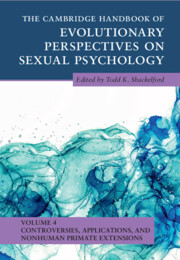Book contents
- The Cambridge Handbook of Evolutionary Perspectives on Sexual Psychology
- The Cambridge Handbook of Evolutionary Perspectives on Sexual Psychology
- Copyright page
- Contents
- Contributors
- Preface
- Part I Controversies and Unresolved Issues
- Part II Applications to Health, Law, and Pornography
- 6 Male Reproductive Health
- 7 Women’s Menstrual Cycles and Ovulation Provide Balanced Estradiol and Progesterone for Fertility and Lifelong Health
- 8 Female Genital Cutting
- 9 Costs of Polygyny
- 10 Male Sexual Disorders
- 11 An Evolutionary Perspective on Female Sexual Concerns and Dysfunctions
- 12 Evolutionary Perspectives on Male Sexual Offending
- 13 Pornography and Male Sexual Psychology
- Part III Nonhuman Primate Sexual Behavior
- Index
- References
6 - Male Reproductive Health
from Part II - Applications to Health, Law, and Pornography
Published online by Cambridge University Press: 30 June 2022
- The Cambridge Handbook of Evolutionary Perspectives on Sexual Psychology
- The Cambridge Handbook of Evolutionary Perspectives on Sexual Psychology
- Copyright page
- Contents
- Contributors
- Preface
- Part I Controversies and Unresolved Issues
- Part II Applications to Health, Law, and Pornography
- 6 Male Reproductive Health
- 7 Women’s Menstrual Cycles and Ovulation Provide Balanced Estradiol and Progesterone for Fertility and Lifelong Health
- 8 Female Genital Cutting
- 9 Costs of Polygyny
- 10 Male Sexual Disorders
- 11 An Evolutionary Perspective on Female Sexual Concerns and Dysfunctions
- 12 Evolutionary Perspectives on Male Sexual Offending
- 13 Pornography and Male Sexual Psychology
- Part III Nonhuman Primate Sexual Behavior
- Index
- References
Summary
The purpose of this chapter is to offer an evolutionarily framed overview of human male reproductive health. The chapter is situated within key themes of the overall volume: the relevance of evolutionary and life history theory; sex differences in reproductive effort and their relevance to lifespan and health; the complementary distinctions between proximate and ultimate causation; the importance of context; and the consistent relevance of senescence for understanding aspects of male reproductive health. The structure of the chapter features precopulatory, copulatory, and postcopulatory sections, with key concepts and illustrations presented. The precopulatory section highlights male reproductive health consequences of intrasexual selection, courtship, and sexual coercion. These consequences include male injuries, death, and concerns over status and secondary sexual characteristics such as muscle that have shaped ancestral, if not also contemporary, reproductive success. The copulatory section covers sexual desire, erectile function, semen parameters, genetic parameters, and sexual satisfaction. Patterns in these aspects of male reproductive health commonly vary with age, health status, and partnership dynamics. Other facets of postcopulatory male reproductive health include reproductive constraints (e.g., contraception), sexually transmitted infections, and prostate cancer. Postcopulatory reproductive health touches on key domains such as partnership and sexual dynamics, metabolic consequences (e.g., physical activity and body composition), mental health (e.g., depression), and neuoroendocrine mechanisms (e.g., brain activity and hormone differences associated with paternal care). The scope of this review encompasses key concerns (e.g., erectile dysfunction, testosterone treatment, infertility) of biomedical approaches to male reproductive health while also expanding the scope to include more precopulatory and postcopulatory aspects, all framed within an overarching evolutionary and life history perspective.
- Type
- Chapter
- Information
- Publisher: Cambridge University PressPrint publication year: 2022



